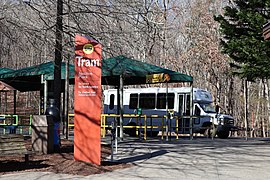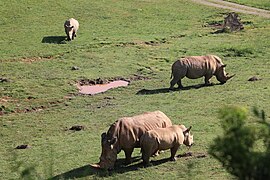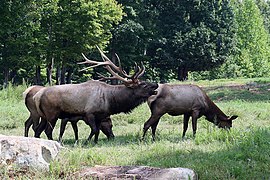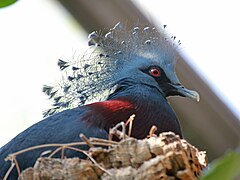North Carolina Zoo
| North Carolina Zoo | |
|---|---|
Asheboro, North Carolina, United States | |
| Land area | 2,600 acres (1,100 ha) total 500 acres (200 ha) developed |
| No. of animals | 1,800+[1] |
| No. of species | 250[1] |
| Annual visitors | 1+ million[3] |
| Memberships | Association of Zoos and Aquariums,[2] NC Zoo Society |
| Major exhibits | Rocky Coast, Kitera Forest, Forest Glade, Desert, Watani Grasslands Reserve, Northwoods, Streamside, Cypress Swamp |
| Website | https://www.nczoo.org |
The North Carolina Zoo, formerly the North Carolina Zoological Park, is a zoo in Asheboro, North Carolina, housing 1,700 animals of more than 250 species, primarily representing Africa and North America. It is one of two state-supported zoos in the United States, with the other being the Minnesota Zoo.[4] With 500 acres (2.0 km2) developed, it is the world's largest natural habitat zoo. The North Carolina Zoo is a part of the North Carolina Department of Natural and Cultural Resources.[5]
The Zoo is 75 miles (121 km) west of
History
In 1967, the
Ground was first broken for the Africa region in the spring of 1976, and the grand opening of the original five habitats took place in the summer of 1980. Today, it is home to a multitude of habitats, including chimpanzees, giraffes, gorillas, zebras, and elephants.
In 1978,
The Zoo has continued to expand ever since. Throughout the 1980s, the habitats of the African region opened. Additionally, the Zoo in 1984 received accreditation from the
The Connect NC bond referendum was approved during the March, 2015 primary election. Funds from the bond will be used to construct a new Asia region to attract more than 1 million people a year.
On August 19, 2022, the zoo officially broke ground on the Asia region of the Zoo.[11]
In addition to providing encounters with wild animals living in natural settings, the North Carolina Zoo offers down-to-earth, authentic and memorable ways for North Americans to play and stay together. The Zoo also offers a variety of nature-based, educational programs and camps.
Future plans
On April 1, 2010, the Zoo announced it had acquired adjacent forestland to bring the total land tract to over 2,000 acres (8.1 km2).[12] The main habitats currently occupy about 500 acres (2.0 km2). The North Carolina Zoo was one of many state facilities to receive money from the Connect NC bond referendum, approved during the March 2015 primary election.[13] In June 2018, the Zoo announced that it is in the final planning stages for two new continents: Asia and Australia. Funds from the Connect NC bond will be used to construct the new Asia region which will include tigers, Komodo dragons, Visayan warty pigs, Asian small-clawed otters, cinereous vultures, red-crowned cranes, wrinkled hornbills, king cobras and northern white-cheeked gibbons among others. The Zoo broke ground on the Asia Continent expansion in August 2022.[14] According to the North Carolina Zoo the Asia Expansion will be complete and open in 2026.
Attractions
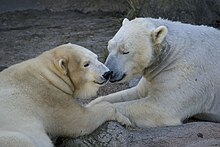
The North Carolina Zoo is home to 1,700 animals of more than 200 species. The zoo is home to one of the largest
in the country. The Zoo is also one of only a few AZA (Association of Zoos & Aquariums) in the U.S. with a breeding pair of polar bears which is part of the Species Survival Plan. As of 2022, the pair have yet to produce any offspring.Layout
The North Carolina Zoo consists of Africa, North America, and a global Desert. There are parking lots located on each end of Africa and North America, so, during peak season, visitors can start their day from either side. With approximately 5 miles (8.0 km) of walking paths, the Zoo also provides trams and air-conditioned buses for visitors.
The North Carolina Zoo's founding philosophy was that of having natural habitats – presenting animals together with plants in habitats that resemble the habitats in which they would be found in the wild. The 40-acre (160,000 m2) Watani Grasslands habitat alone is as large as many entire zoos.
North America
The Cypress Swamp area is home to
Desert

The flora and fauna of deserts are on display in the glass-domed "Mangum Desert". Outside are
Aviary

The R. J. Reynolds Forest Aviary recreated the hot, humid conditions of a tropical forest. The aviary displays more than three thousand tropical plants and allowed visitors to walk among different species of free-flying tropicbirds including, sunbitterns, Victoria crowned pigeons, masked lapwings, Nicobar pigeons, Asian fairy-bluebirds, among many others including Madagascar ibises. The North Carolina Zoo's Aviary was listed among the bird exhibits in the US by USA Today.[17]
On April 21, 2022, the Zoo announced the permanent closure of the R.J. Reynolds Forest Aviary due to structural deterioration caused by high humidity and wet conditions.[18] The aviary had previously been closed since January 2022 due to avian influenza being detected in wild birds in North Carolina.[19] However, efforts are ongoing to potentially rebuild the Aviary in a different part of the zoo. [20]
Africa

The Forest Edge habitat is a 3.5-acre (14,000 m2), lightly wooded grassland enclosure with plains zebras and reticulated giraffes. The Watani Grasslands Reserve mimics the great savannas of Africa, totaling 47-acre (190,000 m2) and is home to a herd of African elephants. Nearby southern white rhinoceroses, Thomson's gazelles, addra gazelles, waterbucks, fringe-eared oryxes, and greater kudu all share a habitat, designed to look as one continuous expanse with the elephants looking out at the rhinos and the antelope. Chimpanzees can be seen in the Kibale Forest habitat. Western lowland gorillas inhabit the Forest Glade exhibit. Lions, hamadryas baboons, and red river hogs each have their own habitats. Red-ruffed lemurs from neighboring Madagascar were also in the Africa region after a refurbishment of the former patas monkey habitat.
Art
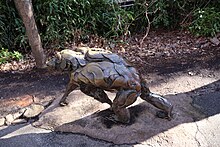
The North Carolina Zoo is home to a large collection of art, primarily sculpture. Also murals, mosaics, and paintings. Primarily depictions of animals and their habitats, the artwork uses a variety of materials including marble, steel, bronze, fiberglass, limestone, glass, cement, and others. The Zoo's art is intended to enliven and enrich the guest experience and help fulfill its mission by "promoting individual discovery and new ways of thinking."[21]
The two largest sculptures are located at the Zoo's main entrances. One, "Sum of the Parts" is a pile of large metal cubes, about a yard (1m) on a side. Most of the cubes are shiny and depict
Research and conservation
Africa
The NC Zoo is involved in several research and conservation projects. Together with the
The Zoo also operates projects in Uganda. An education project around Kibale National Park has been in place for over 10 years and aims to educate young people about the purpose of the park and the value of biological conservation.[25] It also supports research at the Ngogo field research site inside the park. Ngogo researchers study primate plant use and rainforest regrowth after logging among other things, and remove illegal snares from the park which can seriously injure or kill protected animals.
North Carolina
A number of projects are also underway in North Carolina. Protection and research of the
The Zoo is also involved in project to restore the population of endangered
Species Survival Plan
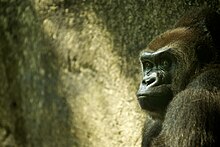
Since 1995, the North Carolina Zoo has been a part of the American Red Wolf Species Survival Plan and reintroduction program. The Zoo is also involved in the gorilla Species Survival Plan and received two female gorillas in early 2010 as part of the effort.
Two southern white rhino calves were born at the North Carolina Zoo during the summer of 2018, with another two born in 2020.
Organization
The Zoo is part of the North Carolina Department of Natural and Cultural Resources. Its operation and development are overseen by a 15-member Zoo Council appointed by the Governor to six-year terms. The director of the North Carolina Zoo is Pat Simmons, formerly the director of Akron Zoo. Simmons took over from long-time director, Dr. David Jones, who retired in 2015. The Zoo's annual operating budget is roughly $18 million. It receives around 60 percent from the state with the remainder being made up of ticket and merchandise sales and donations from the North Carolina Zoological Society, which remains the Zoo's fund-raising and membership arm.[33] The Zoological Society is overseen by its board of directors.[34] The chairman of the board is always a member of the Zoological Council[35] and the two groups meet once annually.[34]
Gallery
-
Tram Bus.
-
Rhinos at the Watani Grasslands.
-
Lion.
-
Zebra.
-
Elk (Cervus canadensis).
-
Hamadryas baboons (Papio hamadryas) socially grooming.
-
Victoria crowned pigeon (Goura victoria).
-
One of the many flowering plants at the zoo.
References
- ^ a b "Animals". Retrieved January 9, 2014.
- ^ "AZA-Accredited Members". Association of Zoos and Aquariums (AZA).
- ^ Franks, Manning. "North Carolina Zoo hits a million visitors in 2023". WFMY News2.
- ^ Matt Hickman (April 2022). "The Minnesota Zoo kicks off transformation of defunct monorail track into elevated pedestrian loop". The Architect's Newspaper.
- ^ "About the Zoo | North Carolina Zoo". www.nczoo.org. Retrieved September 26, 2019.
- ^ a b "Brief History of the North Carolina Zoo" (PDF). Retrieved April 19, 2012.
- ^ North Carolina Zoological Society Timeline Archived July 11, 2010, at the Wayback Machine
- ^ NC Zoo – North Carolina Zoo : Zoo History 1970's
- ^ "Tortoises Take Up Residence at the Zoo | NC DNCR". www.ncdcr.gov. June 7, 2016. Retrieved September 26, 2019.
- ^ Winston Salem Journal
- ^ "North Carolina Zoo Breaks Ground on Asia Expansion". www.nczoo.com. August 19, 2022.
- ^ "Zoo expands with acquisition of nature preserve. News & Record". News-record.com. April 1, 2010. Retrieved April 19, 2012.
- ^ "Connect NC".
- ^ "Asia Continent - Zoo Expansion | North Carolina Zoo".
- ^ "Exhibits at the North Carolina Zoo (PDF)" (PDF). Retrieved April 19, 2012.
- ^ "Sand cats get new exhibit at North Carolina Zoo| MyFox8". www.randolphnewsnow.com. December 16, 2022. Retrieved February 5, 2024.
- ^ "Zoo Tales: NC Zoo Provides Winter Respite". March 7, 2010.
- ^ "North Carolina Zoo Announces the Permanent Closure of its Aviary Habitat | North Carolina Zoo". www.nczoo.org. April 21, 2022. Retrieved April 24, 2022.
- ^ "North Carolina Zoo Closes Aviary to the Public as Precautionary Measure to Protect Birds | North Carolina Zoo". www.nczoo.org. January 24, 2022. Retrieved April 24, 2022.
- ^ "NC Zoo Working to Secure Funding to Rebuild Aviary| North Carolina Zoo". www.randolphnewsnow.com. July 18, 2023. Retrieved February 5, 2024.
- ^ "NC Zoo Art Brochure (PDF)" (PDF). Retrieved April 19, 2012.
- ^ "Cameroon Elephant Conservation NC Zoo". Nczoo.org. Retrieved April 19, 2012.
- ^ "North Carolina Zoological Park Field Conservation and Research Programs (PDF)" (PDF). Retrieved April 19, 2012.
- ^ "Cross River Gorilla Conservation NC Zoo". Nczoo.org. Retrieved April 19, 2012.
- ^ "Unite Nc Zoo". Nczoo.org. Retrieved April 19, 2012.
- ^ "Hellbender Salamander NC Zoo". Nczoo.org. Retrieved April 19, 2012.
- ^ "Schweinitz's Sunflowers NC Zoo". Nczoo.org. Retrieved April 19, 2012.
- ^ Two New Gorillas on Exhibit NC Zoological Society Archived May 8, 2011, at the Wayback Machine
- ^ "NC Zoo™ - North Carolina Zoo : Gorilla Baby Book". Archived from the original on September 19, 2012. Retrieved 2012-11-19.
- ^ "Golden White-Eye" Fox8 WGHP News (video) Archived July 19, 2011, at the Wayback Machine
- ^ a b Anonymous. "Zoo Tales – Rare Bird Species The Randolph Guide". Randolphguide.com. Retrieved April 19, 2012.
- ^ "N.C. Zoo's R.J. Reynolds Forest Aviary Reopens May 26 NCDENR". Enr.state.nc.us. May 16, 2000. Retrieved April 19, 2012.
- ^ "NC Zoological Park Funding and Organization (PDF)" (PDF). Archived from the original (PDF) on February 24, 2012. Retrieved April 19, 2012.
- ^ a b ""The North Carolina Zoological Park Council and Society's Board of Directors Meet Jointly" Zoo and Aquarium Visitor". Zandavisitor.com. Retrieved April 19, 2012.
- ^ "North Carolina statute creating the Zoological Council (PDF)" (PDF). Retrieved April 19, 2012.
External links
- Official website

- North Carolina Zoological Society – the non-profit organization that supports the zoo.

